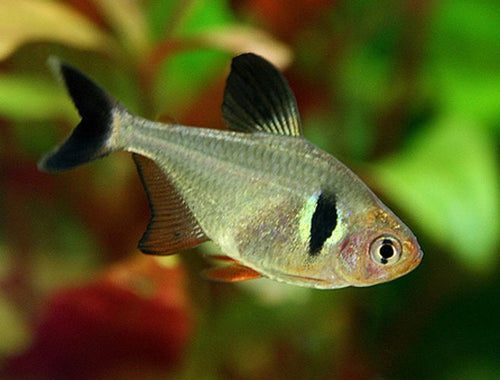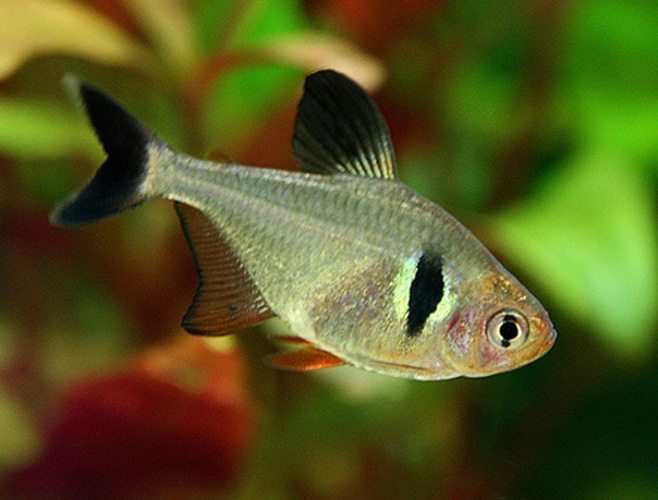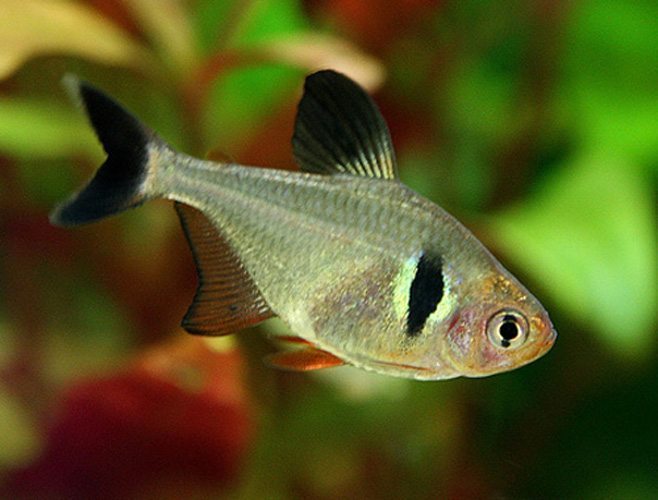Tetra-Black Phantom
Tetra-Black Phantom
check_circle Fast Shipping
check_circle Quality Products
check_circle Affordable Price
Reach out to us on ''available to order'' items via WhatsApp or email
12 in stock
Couldn't load pickup availability

Tetra-Black Phantom
package_2
Product Description
Product Description
All our fish, shrimp and corals are bagged with fresh oxygen as well as a heat pack in winter.
When ordering livestock please select the box size and add it to your cart for accurate overnight (1-2 days) shipping costs. A small box can take 1-2 bags and a medium box 6 bags. One bag fits max 10 small (1-3cm) fish or max 2 medium (3-5cm) fish or max 1 large (>5cm) fish.
ONE SPECIES PER BAG. Eg: One bag of 10 neon tetra
The black phantom tetra comes from northern Paraguay and central Brazil. It is a peaceful schooling fish and a great choice for a community aquarium. The black phantom tetra gets its name from its "eye patch" behind the gills as if a phantom is peering back at you. Although the males are mostly a smokey-silver, the females display some brilliant color. If you add these fish to your aquarium you may even get the chance to observe "mock fight" displays between males. No fish are harmed, and the events can be interesting to watch.
Species Overview
COMMON NAMES: Black phantom petra, phantom tetra
SCIENTIFIC NAME: Megalamphodus megalopterus
ADULT SIZE: 1 3/4 inches (4 1/2 cm)
LIFE EXPECTANCY: 5 years
Characteristics
| Family | Characidae |
|---|---|
| Origin | Paraguay, Brazil |
| Social | Peaceful, rival males, may fin nip |
| Tank Level | Mid-dweller |
| Minimum Tank Size | 10 gallons |
| Diet | Omnivore, eats most foods |
| Breeding | Egglayer |
| Care | Intermediate |
| pH | 6.0 to 7.5 |
| Hardness | to 18 dGH |
| Temperature | 72 to 82 F (22 to 28 C) |
Origin and Distribution
The black phantom tetra makes its home in South America in Bolivia and in areas of western Brazil including the Guaporé River basin and Rio Sao Francisco. In some areas, such as Guapore (Brazil) and Paraguay, they can be found in clear waters that flow into the wetlands of Pantanal. In other areas, however, they prefer slow-moving, murky waters that are thick with vegetation. Black phantom tetras are shoaling fish that live in large groups. In the wild, they eat insects, worms, and crustaceans. The species is under no threat and is widely distributed.
Colors and Markings
Black phantoms make a stunning contrast fish when paired with their red-hued cousins such as the red phantom, jewel, or serpae tetras. They have an attractive, flat, oval body that is silvery gray with a distinctive, vertical splash of black-edged on its front and back with a bluish-white just behind the gills. An odd location for an eye-spot, this splash almost resembles the coloring of a human eye. The real eye of this fish is edged in black on the top and bottom.
Tankmates
Black phantom tetras swim in large groups in the wild, so they do best in groups of at least eight or more in captivity. They also do well with other tetras and look particularly striking when paired with the red phantom tetra. Black phantoms are also compatible with other peaceful species but can be threatened by more aggressive fish. Some good options for tankmates include other live-bearing fish such as gouramis, danios, rasboras, or small, non-aggressive cichlids. Peaceful bottom-dwellers can also share their habitat.
Black Phantom Tetra Habitat and Care
Phantoms prefer a well-planted tank (particularly floating plants), subdued lighting, and a dark substrate such as river sand. You may want to include some dried leaves and driftwood in the tank. Change the water frequently as they are sensitive to poor water quality.
Black phantom tetras are a very active species, so they do best in a tank that is at least 40 inches in length. It's a good idea to have a tight-fitting cover, as black phantom tetras can and do jump. Water parameters are not critical and may be soft to hard, acidic to slightly alkaline.
It is not unusual for the mildly hierarchical males to claim small territories and quarrel with other males at the edges of their turf. Tussles can be intriguing to watch, as the behavior involves unusual "mirroring" that sometimes looks like tandem swimming. The battles are minor and pass without injury, however, frequent challenges add to a state of chronic stress that will shorten life spans. If fish are in conflict daily, rebuild your system into a larger tank.
Black Phantom Tetra Diet and Feeding
Black phantoms are happy eaters, and they will accept most foods. Give them a varied diet of fine flake and freeze-dried foods, as well as small live foods such as brine shrimp, to keep them in optimum health.
Gender Differences
Males can be identified by their longer fins and total lack of red color. Adult males have black fins or fins that are edged in black; the dorsal, ventral, and anal fins are enlarged when compared with the female. Females are deeper-bodied and tend to have reddish pelvic, anal, and adipose fins. If not fully red, they have a definite red tint to their fins and even to the mid-body, which is also fuller than the males. This reddish hue in the females sometimes causes them to be confused with other tetra species.
Breeding the Black Phantom Tetra
Set up a breeding tank with abundant floating plants and dim lighting. Setting it up without a substrate will make the tank easier to keep clean while raising the fry. Prior to spawning, condition the mating pair with small live foods, such as mosquito larvae. Once placed in the breeding tank, keep feeding to a minimum to preserve cleanliness.
Trigger spawning by lowering the pH to 5.5 and dropping the hardness of the water to 4 dGH. Peat filtration is the best method to achieve the necessary water parameters. Males will engage in elaborate courtship fin displays that end with the female release and scattering of up to 300 eggs.
Once the eggs have been laid, remove the breeding pair from the tank. Fry are very sensitive to light, so cover three sides of the tank with cardboard. Perfect water quality is essential to prevent fungal growth on the eggs of this species. Feed every few hours with very small commercially prepared fry food or freshly hatched brine shrimp. After 10 days, feed finely crushed flake foods. Perform water changes at least once a week.


